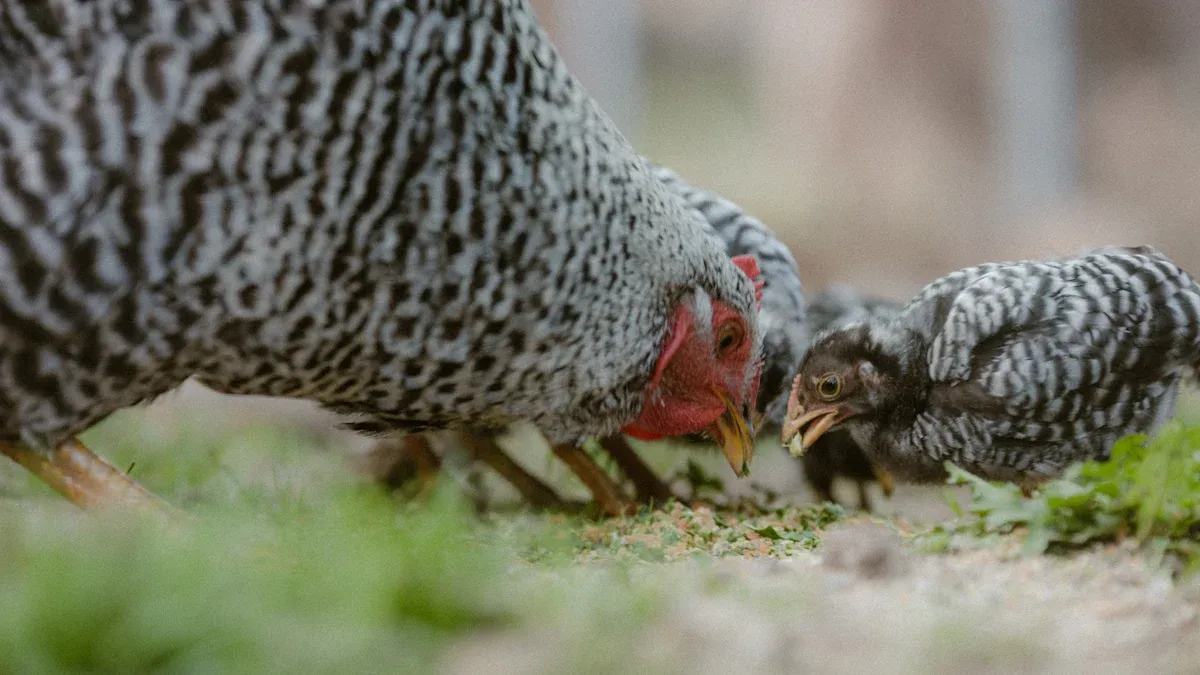
Chickens love a tasty treat, and nothing gets them clucking like dried mealworms 50 lbs. These golden nuggets pack a punch with protein and nutrients. Farmers see their birds strut with shiny feathers and lay eggs with bright yolks. The big bag means happy hens and fewer trips to the store!
Key Takeaways
- Dried mealworms provide high-quality protein and essential nutrients that help chickens grow strong, lay more eggs, and develop shiny feathers, making them a tasty and healthy treat.
- Using dried mealworms supports sustainable farming by reducing land and water use, lowering greenhouse gas emissions, and turning food waste into valuable feed and organic fertilizer.
- Buying dried mealworms in bulk saves money and time, and storing them properly keeps them fresh, while feeding them in moderation ensures happy, healthy chickens without waste.
Nutritional Power of Dried Mealworms 50 lbs
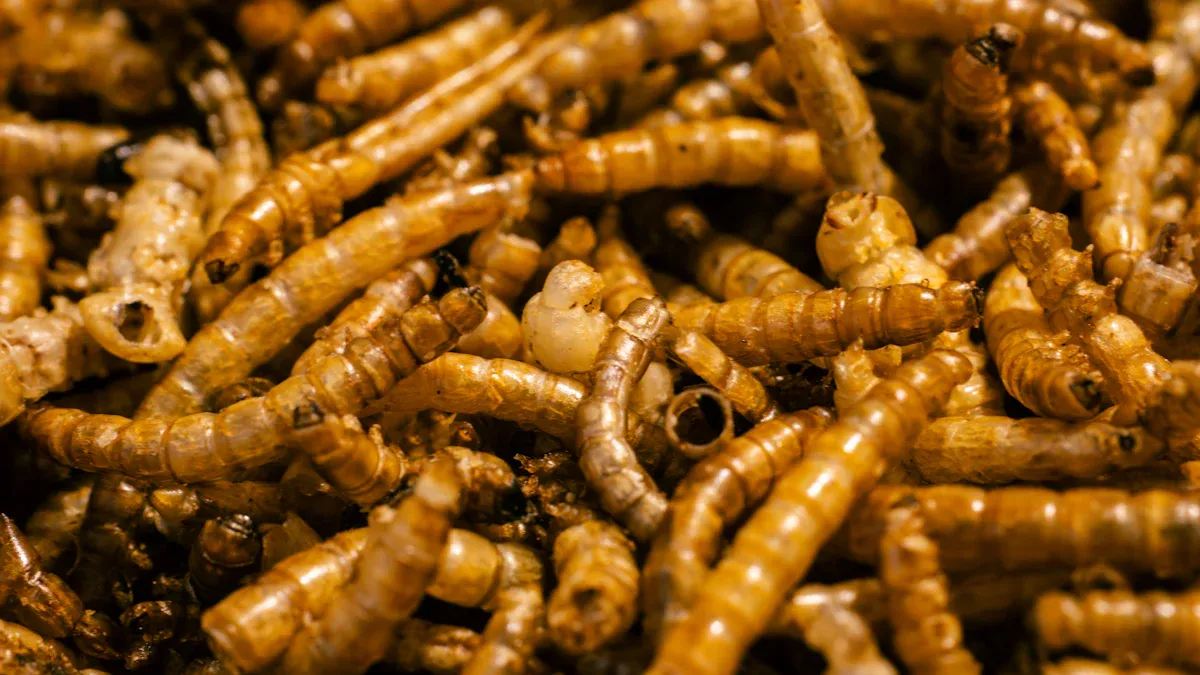
High Protein for Growth and Egg Production
Chickens need protein to grow strong and lay plenty of eggs. Dried mealworms 50 lbs deliver a protein punch that rivals the best feeds on the market. Each 100 grams of dried mealworms contains about Proteína cruda 50%. This level matches or even beats traditional feeds like fishmeal and soybean meal. The protein in mealworms comes packed with essential amino acids such as lysine, methionine, tryptophan, and threonine. These amino acids help chickens build muscle, grow faster, and produce more eggs.
Farmers who add dried mealworms 50 lbs to their flock’s diet often notice more eggs, thicker shells, and richer yolk color. Studies show that including mealworms at 5-10% of a chicken’s diet leads to healthier, more productive birds. Chickens also love to hunt for mealworms, which keeps them active and happy.
Tip: Replace up to 10% of regular chicken feed with dried mealworms for the best results in egg production and bird health.
Essential Vitamins and Minerals for Chicken Health
Dried mealworms 50 lbs are not just about protein. They also bring a treasure chest of vitamins and minerals to the table. These nutrients keep chickens healthy, boost their immune systems, and help them grow.
Here’s a quick look at the mineral content in dried mealworms:
| Essential Mineral | Concentration Range (ppm) |
|---|---|
| Zinc (Zn) | 5.79 – 6.85 |
| Copper (Cu) | 1.08 – 1.29 |
| Calcium (Ca) | 30.26 – 41.96 |
| Iron (Fe) | 2.48 – 3.11 |
| Potassium (K) | 348.94 – 380.42 |
| Phosphorus (P) | 161.10 – 205.80 |
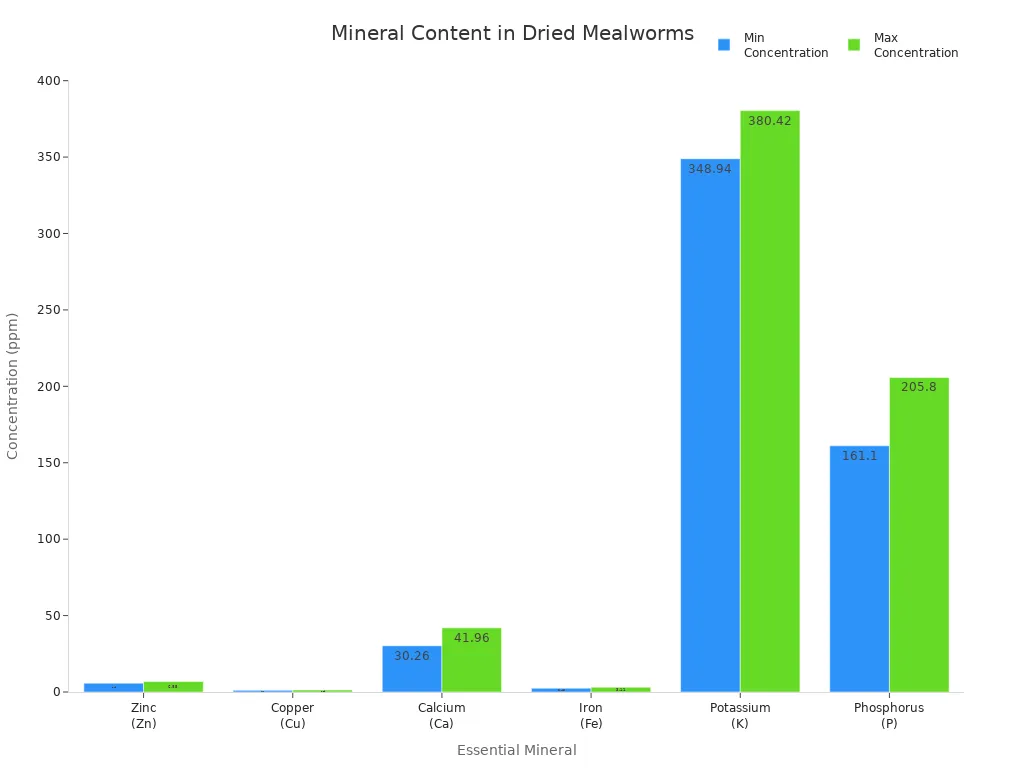
Compared to traditional poultry supplements, dried mealworms offer a nutrient-dense profile. They provide protein levels similar to fish meal and housefly maggots, and higher than soybean meal. Their calcium and phosphorus content supports strong bones and eggshells. Chickens get a boost of zinc, iron, potassium, and magnesium—minerals that keep them lively and healthy.
Benefits for Feather Development and Molting
Feathers make chickens look fabulous, but they also need the right nutrition to grow back after molting. Dried mealworms 50 lbs come to the rescue during this time. Chickens lose feathers and stop laying eggs while they molt. Their bodies need extra protein, calcium, and phosphorus to regrow those shiny feathers.
Mealworms supply all these nutrients in one crunchy package. Farmers and backyard keepers have seen their birds recover faster and look better after adding mealworms to their diet. The high protein content helps chickens rebuild feathers quickly, while calcium and phosphorus support overall health. Chickens strut around with glossy new plumage, ready to face the world again.
Note: Offering dried mealworms during molting gives chickens the extra nutrition they need for a speedy recovery and a beautiful coat of feathers.
Sustainability Advantages of Dried Mealworms 50 lbs
Low Environmental Impact and Resource Efficiency
Mealworms know how to keep things green. Their tiny bodies pack a big punch for the planet. When farmers choose dried mealworms 50 lbs, they pick a protein source that uses much less land and water than beef, pork, or even chicken. Check out this table to see how mealworms stack up:
| Protein Source | Land Use (m²/kg) | Water Use (L/kg) |
|---|---|---|
| Mealworms (dried) | 3.07 | N/A (not explicitly stated) |
| Beef | 27–49 | 15,400–43,000 |
| Pork | 8.9–12.1 | 3,500–6,030 |
| Chicken | 8.1–9.9 | 2,300–6,030 |
A 50 lbs bag of dried mealworms only needs about 70 square meters of land to produce. That’s like the size of a small classroom! Beef needs up to 16 times more land for the same amount of protein. Water use for mealworms stays low, while cows drink up rivers. The greenhouse gas emissions from mealworm farming also stay much lower than those from traditional livestock. Here’s a quick look at the environmental impact:
| Environmental Aspect | Mealworms (per kg edible protein) | Comparison to Soybean Meal and Fishmeal |
|---|---|---|
| Greenhouse Gas Emissions | Significantly lower than traditional livestock | Implied lower than fishmeal and soybean meal (no direct data) |
| Land Use | Much less land required than beef, chicken, pork | Lower land use implied compared to soybean and fishmeal |
| Water Footprint | 4341 m³ per ton, comparable to chicken, 3.5x lower than beef | No direct comparison to soybean or fishmeal provided |
| Uso de energía | Similar to beef and pork per kg fresh mealworms | Not directly compared to soybean or fishmeal |
| Nutrient Profile | Comparable to fishmeal and soybean meal | Suitable alternative feed source |
| Costo | Currently higher (€15/kg) but expected to decline | Soybean meal (€0.33/kg), fishmeal (€1.22/kg) |
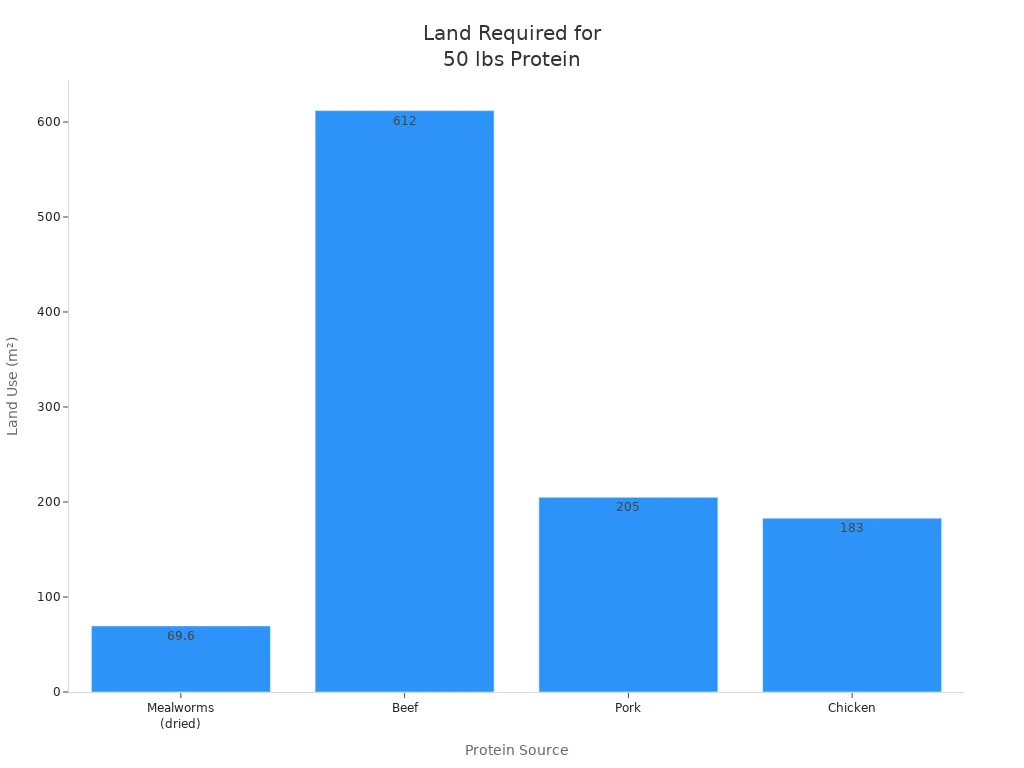
Farmers who care about the earth can feel good about scooping mealworms into the feeder. Less land, less water, and fewer emissions mean a happier planet and healthier chickens.
Supporting Sustainable Agriculture Practices
Dried mealworms 50 lbs do more than just feed chickens. They help farms run smarter and greener. Mealworms turn low-quality food scraps and by-products into high-quality protein. This means less waste and more value from every bite. Here’s what makes mealworms a champion for sustainable agriculture:
- They are 100% natural, organic, and non-GMO.
- Their production uses less water, land, and feed than traditional livestock.
- Mealworms boost animal health and productivity, leading to better eggs and feathers.
- They have a long shelf life and don’t need refrigeration.
- Their farming supports circular food systems by turning waste into valuable feed.
- Using mealworms matches modern values of health and environmental care.
Mealworm farms often feed their insects with food waste that would otherwise end up in landfills. This process slashes greenhouse gas emissions. For every kilogram of protein produced, mealworm farming can reduce emissions by up to 16.39 kg of CO2 compared to landfilling food waste. Even when using regular feed, mealworm farming still beats beef and pork in emissions. The result? A protein source that fits perfectly into a circular economy, where nothing goes to waste and everything gets reused.
Organic Fertilizer Byproducts
Mealworms don’t just make great chicken snacks—they also leave behind a treasure for gardeners and farmers. The byproduct of mealworm farming, called frass, works wonders as an organic fertilizer. This frass is packed with nutrients and helpful microbes. Take a look at what’s inside:
| Nutrient/Component | Composition/Description |
|---|---|
| Nitrogen (N) | Approximately 4.53% (dry matter basis) |
| Phosphorus (P) | Approximately 1.43% (dry matter basis) |
| Potassium (K) | Approximately 1.89% (dry matter basis) |
| Chitin | Present; enhances plant immunity and reduces pesticide need |
| Organic Content | High |
| Carbon to Nitrogen Ratio | Narrow, favorable for soil health |
| Microorganisms | Contains beneficial microbes promoting plant growth and soil health |
Mealworm frass acts like a superfood for soil. It delivers a balanced NPK ratio (about 4-3-4), a neutral pH, and over 85% organic matter. The chitin in frass helps plants fight off pests naturally. Beneficial bacteria in the frass boost plant growth and keep soil healthy. Unlike synthetic fertilizers, frass improves soil quality without polluting water or harming wildlife. Farmers who use mealworm frass see stronger roots, greener leaves, and bigger harvests.
Tip: Sprinkle mealworm frass around your garden or fields to give plants a natural boost and support a healthier ecosystem.
Cost-Effectiveness of Buying Dried Mealworms 50 lbs
Bulk Pricing and Long-Term Savings
Buying in bulk always feels like a win, especially when it comes to chicken treats. Dried mealworms 50 lbs offer a smart way to stretch every dollar. A 44-pound bag costs $289.99, which means each pound comes out to about $6.59. That price makes every scoop feel like a bargain. Smaller bags often cost more per pound, so the big bag brings more value to the coop. Chicken keepers who buy in bulk save money over time and avoid running out of treats when their flock gets extra peckish.
Storage Tips for Maintaining Freshness
Nobody wants stale snacks, not even chickens. Keeping dried mealworms fresh is easy with a few simple tricks. Store the big bag in a cool, dry place away from sunlight. Use airtight containers to lock in crunchiness and keep out pests. Some people even split the bag into smaller containers for easy access. Fresh mealworms keep chickens excited and healthy, so a little storage care goes a long way.
Tip: Label containers with the date opened. This helps track freshness and keeps the rotation smooth.
Reducing Feed Waste
Wasting feed can hurt the wallet and the environment. Dried mealworms 50 lbs make it easy to control portions. Chicken keepers can sprinkle just the right amount, so nothing goes to waste. The birds gobble up every last worm, leaving no mess behind. Less waste means more savings and a cleaner coop. Everyone wins—especially the chickens.
Practical Feeding Guidelines for Dried Mealworms 50 lbs
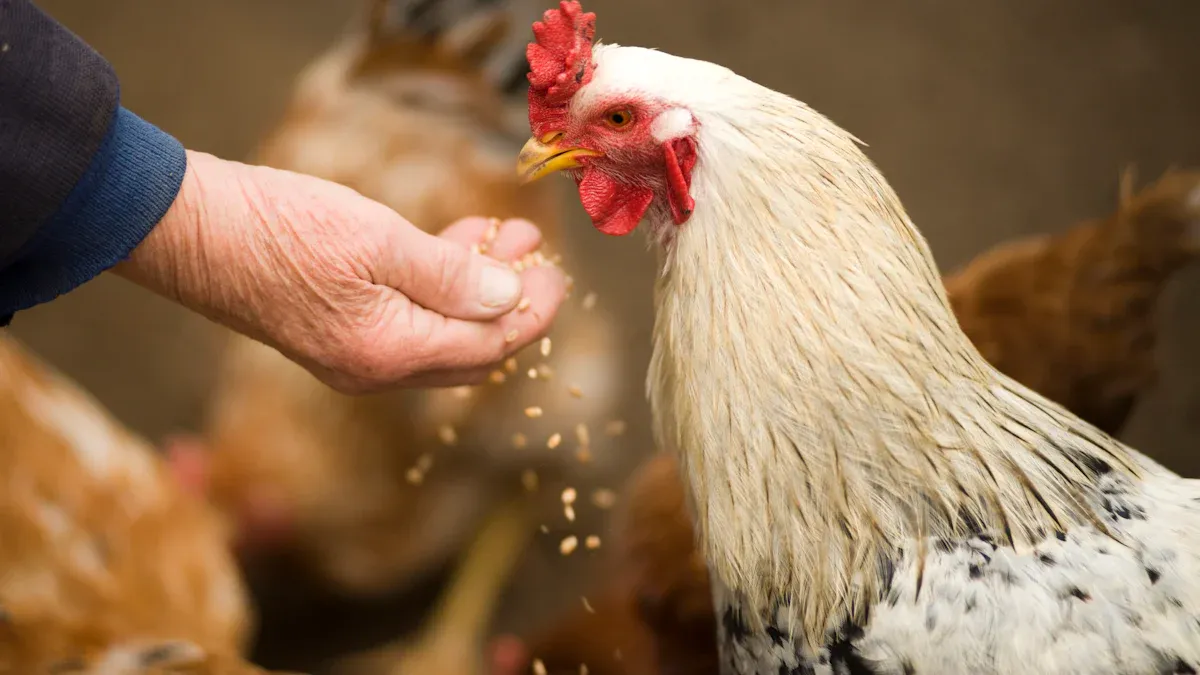
Recommended Serving Sizes and Frequency
Chickens love mealworms, but they need the right amount to stay healthy. Laying hens and broilers have different needs.
- Laying hens need about 0.1 ounce of methionine daily. This equals roughly 0.2 ounces of dried mealworms if their regular feed lacks methionine.
- Broiler chicks can enjoy up to 10% of their diet as mealworms for short periods without any trouble.
- Always check the rest of the diet to make sure chickens get enough methionine but not too much.
- Too many mealworms can upset the balance, so keep treats to a small part of the daily feed.
Integrando los gusanos de la harina en una dieta equilibrada
Mealworms bring a protein boost, but chickens need more than just protein. Mealworms contain about 50% protein, 25% fat, and 7% fiber, but they have very little calcium. Laying hens especially need extra calcium for strong eggshells. Farmers often add oyster shell or limestone to the feed to balance things out. The nutrition in mealworms can change depending on what the worms eat and when they are harvested. Smart poultry keepers mix mealworms with grains, greens, and calcium sources for a complete meal.
Safe Feeding Practices and Moderation
Chickens get excited about mealworms, but safety comes first.
- Start slow. Introduce mealworms gradually to avoid tummy troubles.
- Use mealworms as a treat, not the main course.
- Keep mealworms to less than 10% of the daily feed.
- Always offer fresh water to help with digestion.
- Watch for any signs of digestive upset and keep the diet balanced.
Tip: Happy chickens love variety! Mix mealworms with other treats and watch them peck with joy.
Dried Mealworms 50 lbs vs. Other Protein Sources
Comparison with Traditional Feeds
Chickens love a good protein boost, but not all feeds are created equal. Traditional options like soybean meal and fishmeal have long ruled the roost. However, mealworms bring something special to the table. Check out this table for a quick showdown:
| Feed Type | Protein Content (%) | Crude Fiber Content (%) | Digestibilidad de proteínas | Amino Acid Profile |
|---|---|---|---|---|
| Dried Mealworms | ~39.52 | Higher than soybean (3-5%) and fishmeal (10%) | Similar to soybean meal, slightly lower than fishmeal | Favorable, comparable to fish and poultry meal; lower methionine and lysine than fishmeal |
| Soybean Meal | 49–56 | 3–5 | Similar to mealworms | Standard amino acid profile |
| Harina de pescado | ~60 | 10 | Slightly higher than mealworms | Rich amino acid profile, higher methionine and lysine |
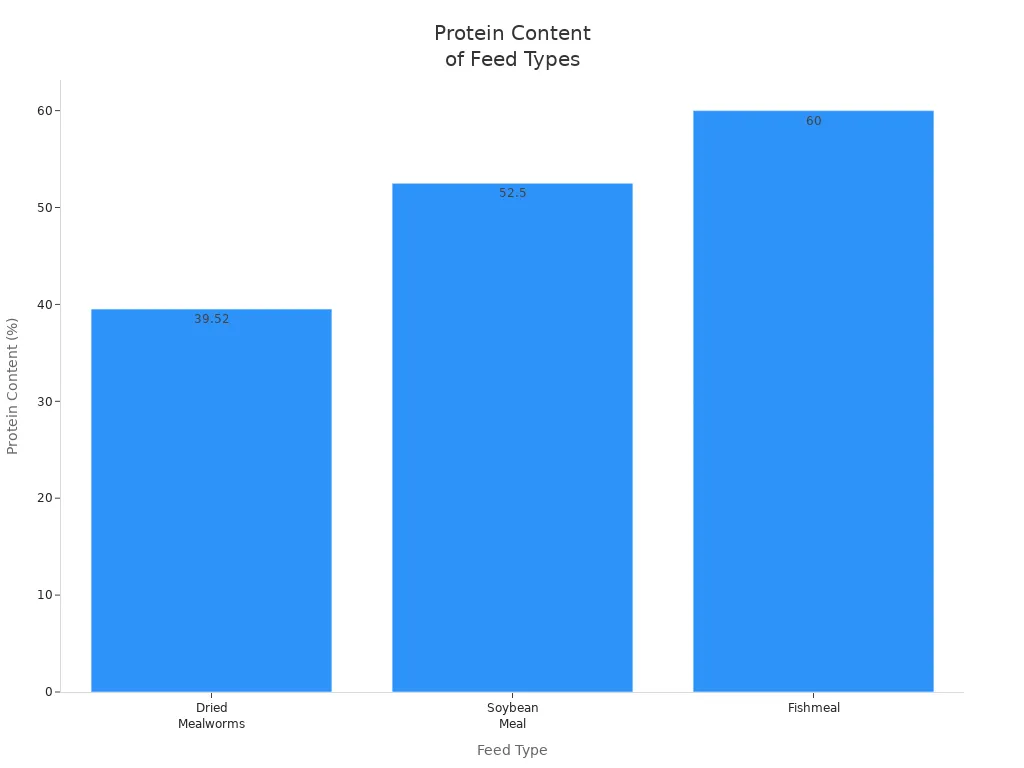
Mealworms may have a bit less protein than fishmeal, but they make up for it with higher fiber and a gut-friendly punch. Chickens get a tasty treat that supports digestion and keeps them pecking for more.
Comparison with Other Insect Proteins
The insect world buzzes with options. Black soldier fly larvae (BSFL) stand out as a strong rival. Mealworms pack about 50% protein, 25% fat, and 7% fiber. BSFL, though, bring a calcium bonanza—about 50 times more than mealworms! This helps chickens build strong bones and lay sturdy eggs. BSFL also win points for sustainability. They munch on food waste, need less space, and leave a tiny carbon footprint. Most BSFL farms pop up close to home, cutting down on shipping emissions. Mealworms still shine with their high protein, but BSFL edge ahead in the eco-friendly race.
Note: Both insects offer great nutrition, but BSFL bring more calcium and a greener reputation.
Advantages Over Plant-Based Proteins
Plant-based proteins like soybeans work hard, but mealworms bring the wow factor. Here’s why chickens and farmers cheer for them:
- Over 50% protein means strong muscles and shiny feathers.
- Mealworms use less water, space, and feed than plants, saving precious resources.
- They help the planet by reducing pressure on farmland and water supplies.
- Chickens lay more eggs with richer yolks after munching on mealworms.
- Mealworms last a long time on the shelf and need no artificial additives.
- Natural foraging with mealworms keeps chickens happy and healthy.
Farmers see healthier flocks and brighter eggs, all while supporting a greener world. That’s a win for everyone—feathers, eggs, and the earth!
- Chickens dance with joy when they see a scoop of dried mealworms.
- Farmers save money and time with bulk bags.
- The planet smiles because mealworms keep things green.
- Dried mealworms 50 lbs turn every flock into a healthy, happy team.
FAQ
How long does a 50 lbs bag of dried mealworms last?
A flock of ten chickens can munch through a 50 lbs bag in about three months. That’s a lot of happy pecking and clucking!
Can chicks eat dried mealworms?
¡Sí! Chicks love mealworms. Start with tiny amounts. Watch them chase every worm like it’s a treasure hunt.
Do dried mealworms need refrigeration?
Nope! Store them in a cool, dry spot. Use an airtight container. Mealworms stay fresh and crunchy, ready for every chicken snack attack.


